June Carter, Johnny Cash, and Pete Seeger sing "As Long as the Grass Shall Grow" which was written by Peter LaFarge...
Accessed from:
http://www.youtube.com/watch?v=aOVU0W1r4YQ
Friday, February 29, 2008
Monday, February 25, 2008
Stones on Boulders
I recently posted about this cave.
Maybe it's just me, but it resembles a turtle facing to the left...
It's probably the true Leatherman Cave, but the caves in the area were called "The Old Hunting Caves," according to some older local histories...
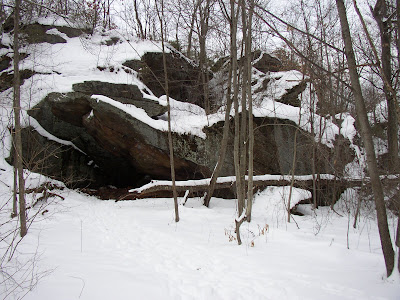
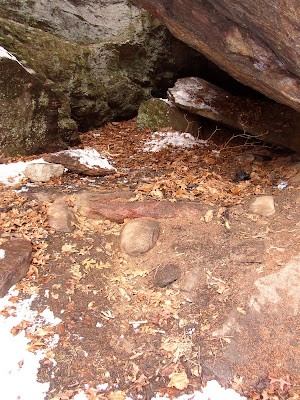
Maybe it's just me, but it resembles a turtle facing to the left...
It's probably the true Leatherman Cave, but the caves in the area were called "The Old Hunting Caves," according to some older local histories...

I once saw "Old John" dig up some shards of Indian pottery here at the fire pit...

I couldn't climb up this in the snow safely, but there's a boulder perched on an outcrop across the little stream:
Sort of lined up, north/south, on the hillside were some boulders with stone piles on them (I'm looking south as I took this one):
Monday, February 18, 2008
coterminous
So I’m sort of rereading Bragdon’s Native People of Southern New England, 1500-1650, and find that my use of “riverine” in describing the Wigwams is incorrect and the proper word is “Lacustrine.”
And then this morning I found three other words underlined in red (but in black here) on page 192:
“(George R.) Hamell’s research focused on those sacred places…metaphorical thresholds between this world and other worlds, the crossing of which entails physical, spiritual, and social transformation. Thresholds might, he argues, be coterminous for farming people with the village clearing…(A)nomalous watery places, springs, whirlpools, swamps, and marshes, many identified with…salamanders, lizards, turtles, frogs, and snakes, as well as…beavers and otters (from Man in the Northeast 1987:67-69, listed in her References as “Mythical Realities and European Contact in the Northeast during the Sixteenth and Seventeenth Centuries” 33: 63-87).
So, consulting an online dictionary, I look up:
co·ter·mi·nous (k -tûr m -n s) adj.
Variant of conterminous.
con·ter·mi·nous
(k n-tûr m -n s) also co·ter·mi·nous (k -)
adj.
1. Having a boundary in common; contiguous: The northern border of the United States is conterminous with the southern border of Canada.
2. Contained in the same boundaries; coextensive: the conterminous 48 states.
3. Having the same scope, range of meaning, or extent in time.
[From Latin conterminus : com-, com- + terminus, boundary.]
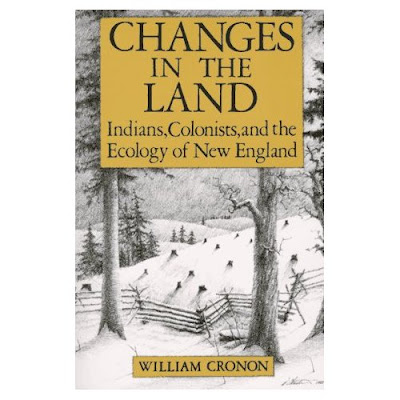
So a little later, I pick up my much underlined “Changes in the Land” by William Cronon, and I’m reading about Villages and find the quote I was sort of thinking about from Edward Winslow who once wrote “Every Sachem knoweth how far the bounds and limits of his Country extendeth,” followed a few sentences later with Cronan saying, “A sachem’s land was coterminous with the with the area within a village’s economic subsistence and political expressions were most immediately expressed.”
Both books speak of the humanly created cultural landscape of the same time, more or less,mostly by controlled burning.
I claim to see (and have been photographing and posting here) remnants of stone rows that sort of seem to outline these very things and could be a way to controll burning, mostly before the great depopulation of the Northeast by disease - and imitated, often unsuccessfully, by early European settlers.
Well, I think so anyway…
And then this morning I found three other words underlined in red (but in black here) on page 192:
“(George R.) Hamell’s research focused on those sacred places…metaphorical thresholds between this world and other worlds, the crossing of which entails physical, spiritual, and social transformation. Thresholds might, he argues, be coterminous for farming people with the village clearing…(A)nomalous watery places, springs, whirlpools, swamps, and marshes, many identified with…salamanders, lizards, turtles, frogs, and snakes, as well as…beavers and otters (from Man in the Northeast 1987:67-69, listed in her References as “Mythical Realities and European Contact in the Northeast during the Sixteenth and Seventeenth Centuries” 33: 63-87).
So, consulting an online dictionary, I look up:
co·ter·mi·nous (k -tûr m -n s) adj.
Variant of conterminous.
con·ter·mi·nous
(k n-tûr m -n s) also co·ter·mi·nous (k -)
adj.
1. Having a boundary in common; contiguous: The northern border of the United States is conterminous with the southern border of Canada.
2. Contained in the same boundaries; coextensive: the conterminous 48 states.
3. Having the same scope, range of meaning, or extent in time.
[From Latin conterminus : com-, com- + terminus, boundary.]

So a little later, I pick up my much underlined “Changes in the Land” by William Cronon, and I’m reading about Villages and find the quote I was sort of thinking about from Edward Winslow who once wrote “Every Sachem knoweth how far the bounds and limits of his Country extendeth,” followed a few sentences later with Cronan saying, “A sachem’s land was coterminous with the with the area within a village’s economic subsistence and political expressions were most immediately expressed.”
Both books speak of the humanly created cultural landscape of the same time, more or less,mostly by controlled burning.
I claim to see (and have been photographing and posting here) remnants of stone rows that sort of seem to outline these very things and could be a way to controll burning, mostly before the great depopulation of the Northeast by disease - and imitated, often unsuccessfully, by early European settlers.
Well, I think so anyway…
Friday, February 15, 2008
Lacustrine
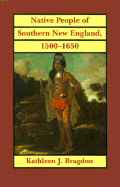
There’s always that word that you meant to look up and then one day you finally do, and it surprises you. Today it’s “Lacustrine.” I was rereading Native People of Southern New England, 1500-1650 by Professor Kathleen J Bragdon, a “comprehensive study of American Indians of southern New England from 1500 to 1650, (In which) Kathleen J. Bragdon discusses common features and significant differences among the Pawtucket, Massachusett, Nipmuck, Pocumtuck, Narragansett, Pokanoket, Niantic, Mohegan, and Pequot Indians.”
The sentence I read on page 35 was “By A.D. 1000, three distinct ecological regions had emerged in southern New England: maritime/estuarine; riverine; and uplands/lacustrine.”
The sentence I read on page 35 was “By A.D. 1000, three distinct ecological regions had emerged in southern New England: maritime/estuarine; riverine; and uplands/lacustrine.”
"Lacustrine plain"
From Wikipedia, the free encyclopedia
From Wikipedia, the free encyclopedia
"A Lacustrine plain is a plain that originally formed in a lacustrine environment, that is, as the bed of a lake, but from which the water has disappeared, by natural drainage, evaporation or other geophysical processes.
The soil of the plain left behind may constitute fertile and productive farm land, due to the previous accumulation of lacustrine sediments. In other cases it may be a wetland or a desert.”
From: http://en.wikipedia.org/wiki/Lacustrine_plain
On page 38, she writes, “…there is very little archeological evidence for village based settlement systems during the Late Woodland period…”
The soil of the plain left behind may constitute fertile and productive farm land, due to the previous accumulation of lacustrine sediments. In other cases it may be a wetland or a desert.”
From: http://en.wikipedia.org/wiki/Lacustrine_plain
On page 38, she writes, “…there is very little archeological evidence for village based settlement systems during the Late Woodland period…”
I’ll go back to a statement from my first post (http://wakinguponturtleisland.blogspot.com/2006/06/first-post.html):
“It's been many years since I woke up to the fact that I live in a special place on Turtle Island.Not that I was actually asleep for a long period of time, but rather I gradually became aware that remnants of ancient stonework was all around me, dismissed as Colonial construction, but (are) really part of a managed cultural landscape that may be hundreds or thousands of years old.”
And I’ll add a little bit using my new word for the day, “On a Lacustrine plain still known by it’s Indian name.”
“It's been many years since I woke up to the fact that I live in a special place on Turtle Island.Not that I was actually asleep for a long period of time, but rather I gradually became aware that remnants of ancient stonework was all around me, dismissed as Colonial construction, but (are) really part of a managed cultural landscape that may be hundreds or thousands of years old.”
And I’ll add a little bit using my new word for the day, “On a Lacustrine plain still known by it’s Indian name.”
Wednesday, February 13, 2008
Stone row in a swamp covered with snow in a flood

It's flooding here today in Western CT. This is the corn field across from my driveway, the river in the distance, a stream (that begins at the rock shelter where it is still zigzag stone bordered) overflowing the ditch of today (or the last couple hundred years or so).
There's a swamp, on Swamp Road oddly enough, 3/4 miles away, to the south, where there's remnants of a Y-shaped stone row, interuppted by a state highway.
That swamp flooded today and it looks sort of interesting, snow covered and sticking up out of the water.
It would make a good panorama, but I can't get that function on the new version of my camera program aafter a crash a while back.
Peter you have my permission to copy and stitch them together for Rock Piles if you like - I might just steal them back in pano-form if you are moved to do so...
Another Park Road

With just under a half hour in which to walk ( required by the "Walk or Die Exercise Program" I've created), I parked over by the entrance to Leatherman Cave, another old favorite of a place of mine. Look up the Leatherman at: http://en.wikipedia.org/wiki/Leatherman_(vagabond) or Google it (on the web or in images) and it will tell you a little bit about him, as well as showing many pictures of "Crane's Look Out," a but not the LM's Cave. There's a little bit about the area atthis blog: http://wakinguponturtleisland.blogspot.com/search?q=leatherman, where I mention it's older name "The Old Hunting Caves." My intention was to photograph some rock piles and a stone worked spring below them, about 200 feet from the True Leatherman's Cave, but it was muddy and I wouldn't have enough time.
So I just walked up the road, which just happens to be called "Park Road."
It's near a State Park but I think the name predates the Park created in 1926: http://ct.gov/dep/cwp/view.asp?a=2716&q=325176.
"Leadmine" in Thomaston is the graphite place. Black Rock used to be covered in Black Lichens and that's where the name really came from.
I found my only quartz arrowhead on a trail here, and witnessed a nice guy named John dig up some Woodland Pottery Shards outof a fire pit right in front of the LM Cave, back tracking to the spot he "had a feeling about."
I didn't think about it until I was leaving and looked at the street sign, wondering if again here's another example of a Deer Park adopted by colonists using an ancient Indian land use scheme.


None of these photos are that great ( You can barely make out the zigzag row at the top center of the photo) but there below the road were stone rows and springs and rock piles I never noticed before...


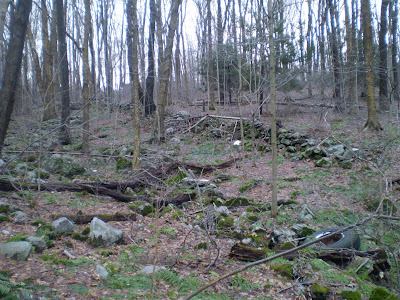

Tuesday, February 12, 2008
(An) Archaeological Perspective
From:
Archaeological Perspectives , Edited by Harold D. Juli
The Institute for American Indian Studies: Preserving the Archaeology, History and Culture of Connecticut's First Settlers
by Lucianne Lavin, Director of Research & Collections, Institute for American Indian Studies (http://www.birdstone.org/)
“Formerly known as the American Indian Archaeological Institute, the Institute for American Indian Studies (IAIS) is a small museum and research center nestled in the beautiful Litchfield Hills of Washington, Connecticut. IAIS is dedicated to preserving and promoting an appreciation of the archaeology, history and living traditions of the indigenous peoples of the Americas, especially in New England…
…From its beginnings, the Institute's main objective was archaeological research. During its formative years in the 1970s and 1980s, directors of research manned large field crews to investigate and dig numerous prehistoric sites in the northwestern highlands of Litchfield County. One of its most famous discoveries was the Templeton site in Washington, a 10,190 year-old Paleo-Indian camp excavated by Dr. Roger Moeller-the oldest archaeological site in southern New England. The site's cultural remains lay three to five feet below the surface of a terrace overlooking the Shepaug River. They included rare fluted spear points and other stone tools used to collect and prepare foodstuffs, slice hides for clothing, and process bone, wood, and plant parts for the manufacture of other non-food items such as bone needles and punches, wooden spear shafts and tool handles, and mats for bedding, sitting, and covering shelters.”
In the late 1980s the Institute began to focus on late prehistoric and early historic Native American sites. Hoping to understand more clearly patterns of settlement and land use among the Weantinock and Pootatuck tribes whose homelands once encompassed much of present Litchfield County, Dr. Russell Handsman instituted an extensive survey of the Housatonic River drainage. Dr. Handsman's research indicates that the landscape contains a long and continuous archaeological record of Native American presence in northwestern Connecticut for thousands of years up to and including the historical period. His findings are in direct contrast to some historical sources, which claim that this region of the state was uninhabited prior to European settlement.
Dr. Handsman believes that this disparity arose because inland Native American settlements and land use patterns were so different from those of contemporary Europeans and coastal Native American societies, that colonists misread the landscapes they encountered, believing them to be uninhabited. In northwestern Connecticut they did not find nucleated, year-round villages, enclosed lands, or extensive agricultural fields. Instead, evidence uncovered by the Institute suggests a different kind of pattern. Following a seasonal round of ripening fruits/plants/nuts, anadromous fish runs, and other animal life-cycles (such as seasonal migratory habits of waterfowl, winter yarding habits of deer, etc), northwestern Connecticut Native Americans practiced a settlement system of semi-sedentary base camps, smaller seasonal camps, and even smaller temporary camps that contained all or portions of the group's population at various times of the year, depending on the tasks at hand…”
Taken from:
http://cttrust.org/7496?highlight=harold
To this I add a little story of my own.
I know someone whose Indian name is “Iron Otter.” We both have daughters named Kate who are the same age, went to the same schools, from Kindergarden to high school. Ever since he was old enough, Iron Otter would go to a fishing spot that his grandfather knew about, where they’d meet up with other Native People, from all over New England who also knew about it. Iron Otter’s grandfather was Moeller’s informant who first showed him what became known as the Templeton site, that very same fishing site. Driving on the back roads, taking various short cuts, I could drive there in 20 or 30 minutes from my house.
My house was very possibly begun to be built around 1700, the time of the “Land Deed” for this “purchase,” by the Indian Interpreter for the “Plantation” that became the town I now live in. Differing concepts of land ownership in mind, it’s very possible that this “Deed” was more of a treaty that implied not an actual sale but more of an agreement to share the resources of the area peacefully. I once read a New Milford history that described a similar sort of deal happening in that town, a house being at least begun to be built on the opposite side of the river from the Indian wigwams, just as my house was. I think the idea was that the English would wait until the Indians moved on and sort of just take over the land, perhaps making a “Confirmatory Deed” to make it a legal deal, from the English Law perspective (the second “purchase” of the same land here I think occurred about 1710 or so).
New Milford became a city – just as New London, Derby and many, many other cities did, built on the sites of many other former Indian cleared fields and what we call Villages from our Euro-centric point of view.
But where I live stayed rural – no factories, no train spur.
The sunrises everyday over the opposite hillside from my house where a Village stood for many years since at least 1659, illuminating the ancient stone fish weir that gives the area it’s Indian Place Name, by the agricultural fields on the other side of the river from my front door, the last floodplain of a chain of floodplains put into cultivation the first year that a group of English people found already cleared by Native American People, where mile after mile of remnants of stone rows remain that perhaps were used to control intentionally set fires as those people maintained the cultural landscape that those people walked and lived upon for at least the accepted 10,190 years, evolving into a culture that remains little understood today…
Archaeological Perspectives , Edited by Harold D. Juli
The Institute for American Indian Studies: Preserving the Archaeology, History and Culture of Connecticut's First Settlers
by Lucianne Lavin, Director of Research & Collections, Institute for American Indian Studies (http://www.birdstone.org/)
“Formerly known as the American Indian Archaeological Institute, the Institute for American Indian Studies (IAIS) is a small museum and research center nestled in the beautiful Litchfield Hills of Washington, Connecticut. IAIS is dedicated to preserving and promoting an appreciation of the archaeology, history and living traditions of the indigenous peoples of the Americas, especially in New England…
…From its beginnings, the Institute's main objective was archaeological research. During its formative years in the 1970s and 1980s, directors of research manned large field crews to investigate and dig numerous prehistoric sites in the northwestern highlands of Litchfield County. One of its most famous discoveries was the Templeton site in Washington, a 10,190 year-old Paleo-Indian camp excavated by Dr. Roger Moeller-the oldest archaeological site in southern New England. The site's cultural remains lay three to five feet below the surface of a terrace overlooking the Shepaug River. They included rare fluted spear points and other stone tools used to collect and prepare foodstuffs, slice hides for clothing, and process bone, wood, and plant parts for the manufacture of other non-food items such as bone needles and punches, wooden spear shafts and tool handles, and mats for bedding, sitting, and covering shelters.”
In the late 1980s the Institute began to focus on late prehistoric and early historic Native American sites. Hoping to understand more clearly patterns of settlement and land use among the Weantinock and Pootatuck tribes whose homelands once encompassed much of present Litchfield County, Dr. Russell Handsman instituted an extensive survey of the Housatonic River drainage. Dr. Handsman's research indicates that the landscape contains a long and continuous archaeological record of Native American presence in northwestern Connecticut for thousands of years up to and including the historical period. His findings are in direct contrast to some historical sources, which claim that this region of the state was uninhabited prior to European settlement.
Dr. Handsman believes that this disparity arose because inland Native American settlements and land use patterns were so different from those of contemporary Europeans and coastal Native American societies, that colonists misread the landscapes they encountered, believing them to be uninhabited. In northwestern Connecticut they did not find nucleated, year-round villages, enclosed lands, or extensive agricultural fields. Instead, evidence uncovered by the Institute suggests a different kind of pattern. Following a seasonal round of ripening fruits/plants/nuts, anadromous fish runs, and other animal life-cycles (such as seasonal migratory habits of waterfowl, winter yarding habits of deer, etc), northwestern Connecticut Native Americans practiced a settlement system of semi-sedentary base camps, smaller seasonal camps, and even smaller temporary camps that contained all or portions of the group's population at various times of the year, depending on the tasks at hand…”
Taken from:
http://cttrust.org/7496?highlight=harold
To this I add a little story of my own.
I know someone whose Indian name is “Iron Otter.” We both have daughters named Kate who are the same age, went to the same schools, from Kindergarden to high school. Ever since he was old enough, Iron Otter would go to a fishing spot that his grandfather knew about, where they’d meet up with other Native People, from all over New England who also knew about it. Iron Otter’s grandfather was Moeller’s informant who first showed him what became known as the Templeton site, that very same fishing site. Driving on the back roads, taking various short cuts, I could drive there in 20 or 30 minutes from my house.
My house was very possibly begun to be built around 1700, the time of the “Land Deed” for this “purchase,” by the Indian Interpreter for the “Plantation” that became the town I now live in. Differing concepts of land ownership in mind, it’s very possible that this “Deed” was more of a treaty that implied not an actual sale but more of an agreement to share the resources of the area peacefully. I once read a New Milford history that described a similar sort of deal happening in that town, a house being at least begun to be built on the opposite side of the river from the Indian wigwams, just as my house was. I think the idea was that the English would wait until the Indians moved on and sort of just take over the land, perhaps making a “Confirmatory Deed” to make it a legal deal, from the English Law perspective (the second “purchase” of the same land here I think occurred about 1710 or so).
New Milford became a city – just as New London, Derby and many, many other cities did, built on the sites of many other former Indian cleared fields and what we call Villages from our Euro-centric point of view.
But where I live stayed rural – no factories, no train spur.
The sunrises everyday over the opposite hillside from my house where a Village stood for many years since at least 1659, illuminating the ancient stone fish weir that gives the area it’s Indian Place Name, by the agricultural fields on the other side of the river from my front door, the last floodplain of a chain of floodplains put into cultivation the first year that a group of English people found already cleared by Native American People, where mile after mile of remnants of stone rows remain that perhaps were used to control intentionally set fires as those people maintained the cultural landscape that those people walked and lived upon for at least the accepted 10,190 years, evolving into a culture that remains little understood today…
Monday, February 11, 2008
New England Indian–related topic in two books

Carl Masthay writes to me in an email: “Here are two books of interest, one a bit of the fringe, the other a dissertation (this latter one I might want to buy for myself).”
1. Rediscovering Vinland: Evidence of ancient Viking presence in America by Fred N. Brown III (2007, 296 pp., photos, index, bibliography, references, paperback; iUniverse, Lincoln, Nebr. ISBN: 978-0-595-43680-4; also available as an eBook). I may have mentioned that, having grown up around possible Viking sites such as America’s Stonehenge in New Hampshire, I’ve been avidly interested in the whole subject of pre-Columbus visitors to our land. Based on 15 years of research and the culturally rich Vinland Sagas, this book uses such evidence as DNA, language, customs, and immunity to tuberculosis to show that the Narragansett and Wampanoag tribes of the regions visited who the early English settlers were, in fact, genetically similar to Europeans and were descendants of mixed Indian-Viking populations!
Tom Elliott, Book Review Editor, Mensa Bulletin, 14R Russell St., Waltham, MA 02453-8505
Reviewed in Mensa Bulletin, January 2008, p. 39.
2. [To buy for later? C.M.] [Note in Algonquian and Iroquoian Linguistics 32(4):25-26, 2007]
White, Kevin J., 2007: Haudenosaunee Worldviews through Iroquoian Cosmologies: The Published Narratives in Historical Context. Ph.D. dissertation. State University of New York at Buffalo. 670 pp. AAT 3262030 [AAT is some kind of catalog number for dissertations. The on-line source is called Digital Dissertations I think, Then you can order and download, billing it to a credit card or hard copy like the old University Microfilms used to do. John Nichols]
“Returning to the original published Iroquois (or Haudenosaunee) cosmologies, I shed new light on the development of interpretation and revelation as it pertains to the Haudenosaunee. I analyze and edit J.N.B. Hewitt’s “Iroquois Cosmology Part I” to reveal the scholar, the informant, and a unique clash of their worldviews. Hewitt was a baseline for comparison to other published narratives that I have assembled here in contrast to William N. Fenton’s analysis in his 1962 article “This Island, the World on Turtle’s Back.” I examine in detail translations of the cosmologies, including some by modern Native scholars presented on the World Wide Web. My examination of these works reveals transitions in both Native and non-Native thinking over the centuries of contact. Patterns of change show an indigenous culture struggling to balance ancient traditions, sacred beliefs, and obligations to generations yet unborn against the assimilationist tide of the larger Western culturre. I attempt to excite a discussion about the theology, philosophy, and cosmology grounded in more subtle understandings of Haudenosaunee cultures. Finally, I use the examination of outside/inside views of cosmologies to suggest further fertile study of the other major ethnographic works conventionally used to construct and interpret worldview, theology, and understandings of indigenous groups.
The complex history associated with the Haudenosaunee is steeped in problematic thinking. Though Haudenosaunee voices are present as informants, the knowledge, wisdom, and worldview are hidden in condensed and filtered formats of academic literature. The preferred voices are those like William N. Fenton and David Cusick while the designated Holders of Tradition within the culture are muted. Modern Haudenosaunee scholars contribute interpretations of this ancient worldview grounded in their own theological and philosophical contexts as practitioners of these ancient conceptual frames of reference. Also revealing in this dismissal is a tendency to treat Iroquois [different] from any of the founding Six Nations (Mohawk, Oneida, Onondaga, Cayuga, Tuscarora, and Seneca) as members of one homogeneous group. By placing all these published works side by side, I allow the reader to draw individual conclusions, as though they were part of an audience hearing this among a group.”
Email communication (2/10/08) from Carl Masthay, mentioned on an earlier blog:
http://wakinguponturtleisland.blogspot.com/2006/12/christmas-and-new-years-greetings.html
1. Rediscovering Vinland: Evidence of ancient Viking presence in America by Fred N. Brown III (2007, 296 pp., photos, index, bibliography, references, paperback; iUniverse, Lincoln, Nebr. ISBN: 978-0-595-43680-4; also available as an eBook). I may have mentioned that, having grown up around possible Viking sites such as America’s Stonehenge in New Hampshire, I’ve been avidly interested in the whole subject of pre-Columbus visitors to our land. Based on 15 years of research and the culturally rich Vinland Sagas, this book uses such evidence as DNA, language, customs, and immunity to tuberculosis to show that the Narragansett and Wampanoag tribes of the regions visited who the early English settlers were, in fact, genetically similar to Europeans and were descendants of mixed Indian-Viking populations!
Tom Elliott, Book Review Editor, Mensa Bulletin, 14R Russell St., Waltham, MA 02453-8505
Reviewed in Mensa Bulletin, January 2008, p. 39.
2. [To buy for later? C.M.] [Note in Algonquian and Iroquoian Linguistics 32(4):25-26, 2007]
White, Kevin J., 2007: Haudenosaunee Worldviews through Iroquoian Cosmologies: The Published Narratives in Historical Context. Ph.D. dissertation. State University of New York at Buffalo. 670 pp. AAT 3262030 [AAT is some kind of catalog number for dissertations. The on-line source is called Digital Dissertations I think, Then you can order and download, billing it to a credit card or hard copy like the old University Microfilms used to do. John Nichols]
“Returning to the original published Iroquois (or Haudenosaunee) cosmologies, I shed new light on the development of interpretation and revelation as it pertains to the Haudenosaunee. I analyze and edit J.N.B. Hewitt’s “Iroquois Cosmology Part I” to reveal the scholar, the informant, and a unique clash of their worldviews. Hewitt was a baseline for comparison to other published narratives that I have assembled here in contrast to William N. Fenton’s analysis in his 1962 article “This Island, the World on Turtle’s Back.” I examine in detail translations of the cosmologies, including some by modern Native scholars presented on the World Wide Web. My examination of these works reveals transitions in both Native and non-Native thinking over the centuries of contact. Patterns of change show an indigenous culture struggling to balance ancient traditions, sacred beliefs, and obligations to generations yet unborn against the assimilationist tide of the larger Western culturre. I attempt to excite a discussion about the theology, philosophy, and cosmology grounded in more subtle understandings of Haudenosaunee cultures. Finally, I use the examination of outside/inside views of cosmologies to suggest further fertile study of the other major ethnographic works conventionally used to construct and interpret worldview, theology, and understandings of indigenous groups.
The complex history associated with the Haudenosaunee is steeped in problematic thinking. Though Haudenosaunee voices are present as informants, the knowledge, wisdom, and worldview are hidden in condensed and filtered formats of academic literature. The preferred voices are those like William N. Fenton and David Cusick while the designated Holders of Tradition within the culture are muted. Modern Haudenosaunee scholars contribute interpretations of this ancient worldview grounded in their own theological and philosophical contexts as practitioners of these ancient conceptual frames of reference. Also revealing in this dismissal is a tendency to treat Iroquois [different] from any of the founding Six Nations (Mohawk, Oneida, Onondaga, Cayuga, Tuscarora, and Seneca) as members of one homogeneous group. By placing all these published works side by side, I allow the reader to draw individual conclusions, as though they were part of an audience hearing this among a group.”
Email communication (2/10/08) from Carl Masthay, mentioned on an earlier blog:
http://wakinguponturtleisland.blogspot.com/2006/12/christmas-and-new-years-greetings.html
Sunday, February 10, 2008
What In The World Is A Gungywamp?
By MARLENE CLARK
The Hartford Courant February 6, 2008
"Gungywamp is a 100-acre area in Groton that archaeologists consider a treasure. Its exact origins remain a mystery, but its unusual stonework and artifacts span centuries, if not eons…
Some say ancient Native Americans used the area and built the structures for religious ceremonies prior to the Colonial era.
Researchers have associated the name, "Gungywamp," with ancient Gaelic, Mohegan, Pequot, and Algonquin terms meaning "church of the people"; "place of ledges"; "swampy place"; or "all powerful" and "white," respectively. Or it could be a corruption of the phrase, "spongy swamp." Gungywamp is all on private property.
Researchers include members of the Gungywamp Society, an education and research group dedicated to preserving Gungywamp and other archaeological sites in Connecticut.Information also is available at www.gungywamp.com and at www.stonestructures.org/html/gun gywamp.html."
http://www.courant.com/news/local/hc-asked0206.artfeb06%2C0%2C3034208.story
The Hartford Courant February 6, 2008
"Gungywamp is a 100-acre area in Groton that archaeologists consider a treasure. Its exact origins remain a mystery, but its unusual stonework and artifacts span centuries, if not eons…
Some say ancient Native Americans used the area and built the structures for religious ceremonies prior to the Colonial era.
Researchers have associated the name, "Gungywamp," with ancient Gaelic, Mohegan, Pequot, and Algonquin terms meaning "church of the people"; "place of ledges"; "swampy place"; or "all powerful" and "white," respectively. Or it could be a corruption of the phrase, "spongy swamp." Gungywamp is all on private property.
Researchers include members of the Gungywamp Society, an education and research group dedicated to preserving Gungywamp and other archaeological sites in Connecticut.Information also is available at www.gungywamp.com and at www.stonestructures.org/html/gun gywamp.html."
http://www.courant.com/news/local/hc-asked0206.artfeb06%2C0%2C3034208.story
Wednesday, February 06, 2008
Heap of Stones

Another old engraving of another "Heap of Stones" from another old history...
A History of Connecticut
By Elias Benjamin Sanford
By Elias Benjamin Sanford
"The common tradition has been, that, having taken the captive chief back to the spot where he had been seized as a prisoner, the brother of Uucas, who was marching behind Miantonomo, with a single blow of his hatchet killed him. In the same spot, still known as " Sachem's Plain," he was buried. An immense heap of stones long marked the grave, placed there by the hands of his tribe, who visited it at each anniversary of the death of their chief, and with loud lamentations expressed their grief.
Some years ago a block of granite, inscribed with his name and the year of his death, was placed over the grave of the brave and gifted Narragaiisett chief..."
Page 46/47 HISTORY OF CONNECTICUT. [1643.
http://books.google.com/books?id=VhUCAAAAYAAJ&pg=PA11&dq=history+of+indians+in+connecticut#PPA47,M1
Perspective (Again)
As happens more often than I can keep up with in writing, when I get my daily fix at Rock Piles, that Peter is looking at or thinking about something very similar to what I'm looking at or thinking about too.


 From the air and the topographic map of 1955, the older power lines only...
From the air and the topographic map of 1955, the older power lines only...
I tend to look at things from different perspectives from time to time in many aspects of my life and especially when revisiting sites that I've come across - or neglected to look at very closely sometimes, this spot for example. The photo is taken standing under the older power lines of the 1930's. That day I just happened to notice the big stone on the left:
I got a little closer:

I remember spotting more stones and eventually saw in the snowy perspective how evenly spaced they were from each other, placed on an angle to the contour of the land, perhaps you could say like diagonal lines on the hillside. I took this picture looking back toward a linear row...

And I found I didn't have a wide enough field of view with my camera to capture the "grid-like" stones, but now that I see Peter's photo, I'll try again when more snow falls and conditions are similar (I hope).
Did I just say "I hope it snows"??
(This is the linear row:)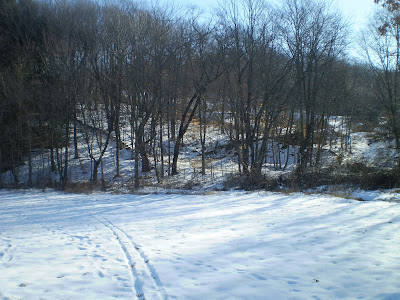



Friday, February 01, 2008
"crappy useless bit of land"
I think I understand my friend Peter's use of the phrase "crappy useless bit(s) of land" -
here's another bit in the corner of Industrial Zoned land for sale...
to be continued....


Subscribe to:
Posts (Atom)















